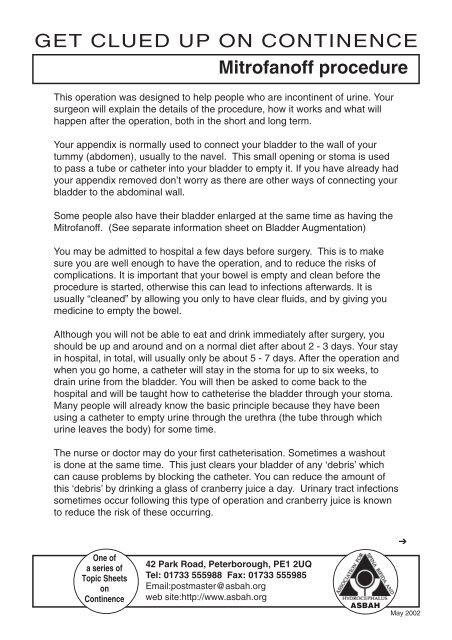Mitrofanoff procedure
Mitrofanoff procedure
Mitrofanoff procedure
You also want an ePaper? Increase the reach of your titles
YUMPU automatically turns print PDFs into web optimized ePapers that Google loves.
GET CLUED UP ON CONTINENCE<strong>Mitrofanoff</strong> <strong>procedure</strong>This operation was designed to help people who are incontinent of urine. Yoursurgeon will explain the details of the <strong>procedure</strong>, how it works and what willhappen after the operation, both in the short and long term.Your appendix is normally used to connect your bladder to the wall of yourtummy (abdomen), usually to the navel. This small opening or stoma is usedto pass a tube or catheter into your bladder to empty it. If you have already hadyour appendix removed don’t worry as there are other ways of connecting yourbladder to the abdominal wall.Some people also have their bladder enlarged at the same time as having the<strong>Mitrofanoff</strong>. (See separate information sheet on Bladder Augmentation)You may be admitted to hospital a few days before surgery. This is to makesure you are well enough to have the operation, and to reduce the risks ofcomplications. It is important that your bowel is empty and clean before the<strong>procedure</strong> is started, otherwise this can lead to infections afterwards. It isusually “cleaned” by allowing you only to have clear fluids, and by giving youmedicine to empty the bowel.Although you will not be able to eat and drink immediately after surgery, youshould be up and around and on a normal diet after about 2 - 3 days. Your stayin hospital, in total, will usually only be about 5 - 7 days. After the operation andwhen you go home, a catheter will stay in the stoma for up to six weeks, todrain urine from the bladder. You will then be asked to come back to thehospital and will be taught how to catheterise the bladder through your stoma.Many people will already know the basic principle because they have beenusing a catheter to empty urine through the urethra (the tube through whichurine leaves the body) for some time.The nurse or doctor may do your first catheterisation. Sometimes a washoutis done at the same time. This just clears your bladder of any ‘debris’ whichcan cause problems by blocking the catheter. You can reduce the amount ofthis ‘debris’ by drinking a glass of cranberry juice a day. Urinary tract infectionssometimes occur following this type of operation and cranberry juice is knownto reduce the risk of these occurring.➔One ofa series ofTopic SheetsonContinence42 Park Road, Peterborough, PE1 2UQTel: 01733 555988 Fax: 01733 555985Email:postmaster@asbah.orgweb site:http://www.asbah.orgASBAHMay 2002
The catheterisation is not a sterile <strong>procedure</strong>, but is a clean one. Make sureyou have everything you need before you start.● A new catheter each time you catheterise.● Somewhere to wash/clean your hands● A container to collect the urineWash your hands and prepare your catheter. Gently introduce the catheterinto your stoma, making sure you go far enough in to drain the urine. Whenthe urine has stopped draining, slowly remove the catheter, and throw it awayor rinse it and store in a clean container, depending on the type of catheter youuse. Wash your hands again.As with all types of surgery, sometimes problems do occur. The stoma canoccasionally become narrowed (stenosed) and if it becomes difficult for you tocatheterise your stoma, this could be the reason. If this happens it is importantfor you to contact your doctor or specialist nurse immediately. At this stage, ifa problem is developing, it is fairly easy to correct. This usually means eitherleaving a catheter in for a few days or stretching the stoma (not as bad as youthink!). Do not wait until you cannot pass the catheter at all, as this can oftenbe too late and will need more major surgery to fix. Apart from problems withstenosis of the stoma, difficulties in completely emptying the bladder and infectionsin the urine can occur.You should also let your doctor or nurse know if you have any of thefollowing:●●●●●blood in the urineyour urine is smellyyou have a temperature and are shivering or sweatingyou cannot drain any urineyour stoma leaksNever leave catheterisation for longer than four hours during the day. Yourbladder may overfill and there is a real risk that it could burst.You may find it helpful to wear a “Medic-Alert” (Tel: 020 7833 3034) toalert medical professionals that you have had a <strong>Mitrofanoff</strong>.If you have any problems or questions concerning your <strong>Mitrofanoff</strong>, youshould ask your doctor, continence nurse or ASBAH Specialist Adviser.





